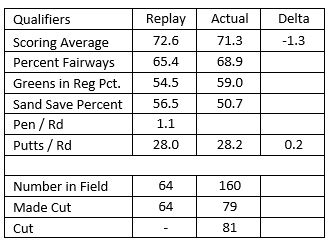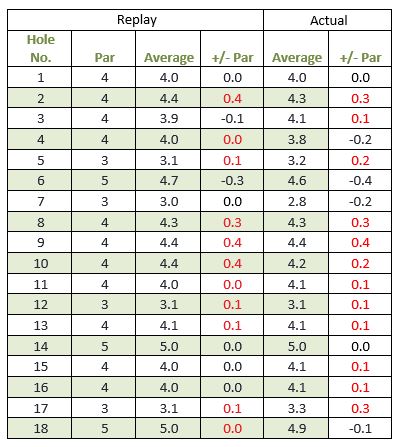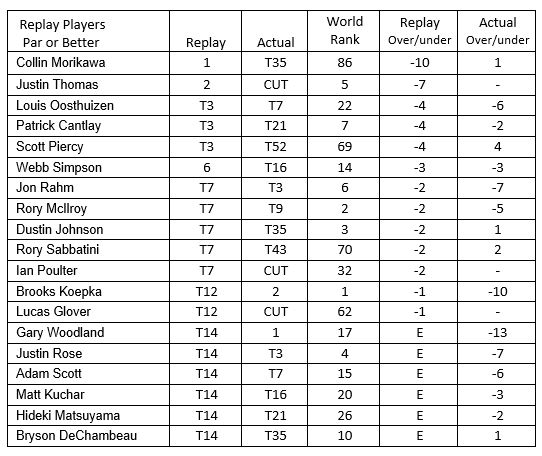The following is a “reprint” of a post that originally appeared on the APBA Between the Lines forum.
The 2019 US Open at Pebble Beach differed a bit from previous US Open events at that location in that 28 players shot under par with Gary Woodland winning at 13 under. For example, in 2010 the winner, Graeme McDowell, shot even par to win; all others were over par. In the 2019 US Open, temperatures ranged from 59 to 67 degrees F, skies partly cloudy to overcast, and winds were from the West or WNW at typically 5 – 14 mph. From all reports, the fairways and greens were receptive. The general game rules would call that Normal to Soft Conditions and Calm winds. At Seaside that’s also a Prevailing Wind Type A, which means Tail winds for holes No. 9 and 10, two of Seaside’s cliff-lined, longer and more difficult Par 4s.
The replay offered a much different situation. Following the usual Dice rolling procedure, the Wind/Course Conditions were as follows: Day 1 – Blustery-A/Normal; Day 2 – Blustery-A/Normal; Day 3 – Blustery-A/Dry; Day 4 – Blustery-B/Wet. Those that have played the APBA Seaside Course (rated J) know that there is no option for a Calm Day. Day 4 presented the additional challenge of easterly winds that turned those favorable tail winds on hole 9 and 10 into heads winds. In the replay, pin selections were 4, 6, 1 and 2.
Also note that several holes have a double-the-wind instruction for certain shots. Applying the 2X wind result of a 30-yard wind effect on a 100-yard approach shot next to the cliffs produced a few high-score outcomes, particularly on the short par 3 No. 7. That meant the hybrid club that also doubles wind effects was an extremely high-risk club selection, and that layups and knockdowns were often the best strategies on a number of holes. Finally, Seaside’s small greens made pin-seeking risky, especially on hole locations at the edge of cliffs. Rough surrounding most greens on all sides but the front, along with many sand traps, also made pin-seeking a risky strategy as well as increased the importance of maintaining ‘good angles’ to control approaches.
The replay was conducted in accordance with the full set of Master game and optional rules. Sixty-four players who participated in the actual US Open (out of the 80-card 2019 card set) played all 4 rounds of the replay event. Par was 71 with Hole 2 played as a Par 4 in both the actual event and the replay. With the difference in conditions and in the exact field of participants noted, the actual event Qualifiers who made the cut bettered the replay group by 1.3 strokes per round. As shown in the table below, the actual event players were slightly better in the categories of fairways hit and greens in regulation. The replay players were slightly better in sand saves. Putting was roughly even.

Played at about 7,000 yards to a par of 71, on a hole-by-hole basis Seaside’s course results (actual vs replay) were remarkably similar. On Nos. 4, 7, and 10 the actual event players played better than the replay players by 0.2 strokes per hole on average. The replay players bettered the actual players on No. 17 by the same margin. In both cases, holes 2 (a par 5 normally), 8, 9, and 10 presented the greatest challenges. Hole 6, a Par 5, was the easiest. These results are summarized in the table below.

So, who won? It was not any of the top ten world-ranked players, though all but Tiger Woods and Xander Schauffele finished even par or better. It wasn’t the actual winner, Gary Woodland, though he too finished even par in the replay. It turned out to be a 2020 Major winner and emerging star, Collin Morikawa, at 10 under. Collin tied for the lead in fairways hit, led in bogie avoidance and of course had the lowest overall score. He was amazingly consistent for all 4 rounds, never shooting the day’s lowest round, yet also never shooting above par. Justin Thomas finished 3 back at 7 under.
The top replay finishers scores and their actual event scores are provided in the table below.

A complete set of tournament reports from the Game Caddie Record Book (GCRB) can be viewed by clicking on the pop-out control (at upper right) in the document below.